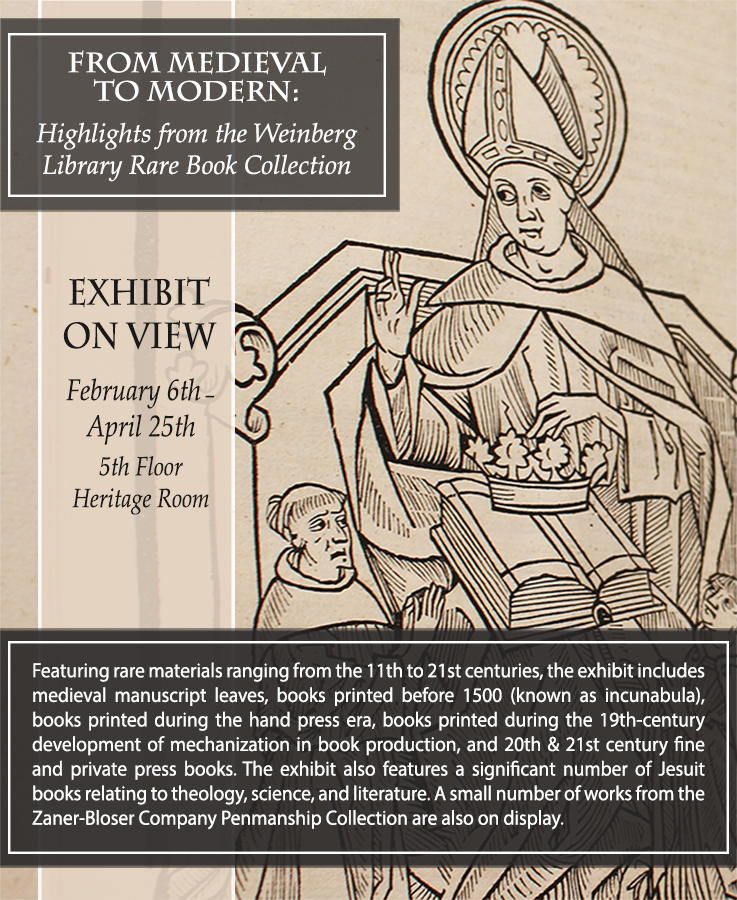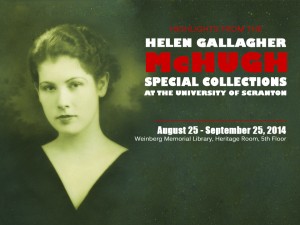Tag: rare books
18th Century Liturgical Books
A selection of rare materials from McHugh Special Collections is currently on view in the Library’s 5th floor Heritage Room. This week we are highlighting three 18th century liturgical books (2 breviaries and a missal) from the exhibit “From Medieval to Modern”. These books are special for their ecclesiastical coats of arms and elaborate decorated bindings.
The first is the Diurnale Ebroicense (1740) by Pierre Jules César de Rochechouart (1698-1781), a French ecclesiastical man who served as Bishop of Evreux and then as Bishop of Bayeux. A Diurnale is a condensed version of a breviary, and in this case, the summer volume Pars Aestiva, from Pentecost though the 15th Sunday after Pentecost. However, this volume also contains sections for the autumn. The Diurnale Ebroicense is based on the rites practiced in Ebroicense, also known as Évreux, a diocese in northern France. This red leather binding features the coat of arms of an unidentified ecclesiastical, possibly a Bishop.
The next is the Breviarium Romanum (1740), which is a very elaborately decorated breviary that features repeating floral designs on red leather, gilt edges, and the arms of an unidentified ecclesiastical, possibly a Bishop. Finally, there is the Canon Missae. Canon Missae is the name used in the Roman Missal for the fundamental part of the Mass that comes after the Offertory and before the Communion. This impressive volume was printed at the Vatican in 1784. The engraving of the Last Supper was engraved by Carolus Grandi after an original by Joseph Passarus. The ornate gold-tooled binding features rather large floral tools that would have required significant strength to impress into the leather. It also features the arms of an unidentified ecclesiastical, possibly a Bishop.



To read more about the Weinberg Library’s Rare Book Collection visit our collection page here. “From Medieval to Modern” will be on display during normal library hours through Tuesday, April 25. On Tuesday, April 11th, Special Collections Librarian Michael Knies will discuss the exhibit at 6 p.m. in the Heritage Room of the Library. A reception will immediately follow the talk. This event is free and open to the public. For more information, please email michael.knies@scranton.edu or call 570- 941-6341.
From Medieval to Modern: The Book of Hours
A selection of rare materials from McHugh Special Collections is currently on view in the Library’s 5th floor Heritage Room. This week we are highlighting the Book of Hours from the exhibit “From Medieval to Modern”.
The Book of Hours was a Christian devotional book that became popular in northern Europe during the 14th century and has been called the Medieval best seller as many educated men and women owned them. The Book of Hours was a distillation, for laypeople, of the series of prayers said by priests, monks, nuns, etc. during the course of the day divided into sections from morning through the night. Although containing a similar collection of texts, prayers, and psalms, there is a high variation in quality depending on the budget of the purchaser. As result, each manuscript was unique with its illumination and binding. Most examples are small books with little illumination, often restricted to decorated capital letters at the start of psalms and prayers. However, the books made for the wealthy can be extremely lavish and heavily illuminated with full-page decorations and have extravagantly decorated bindings.
On display in the Heritage Room are several examples of the Book of Hours from Special Collections: two medieval leafs, a simple book, and a fine art facsimile. The first leaf is from a fine Book of Hours with inhabited borders (ca. 1440). The second leaf is from an undistinguished Book of Hours (ca. 1450-75), but has significance because it records information in French on the Dumesnil family from Loire.
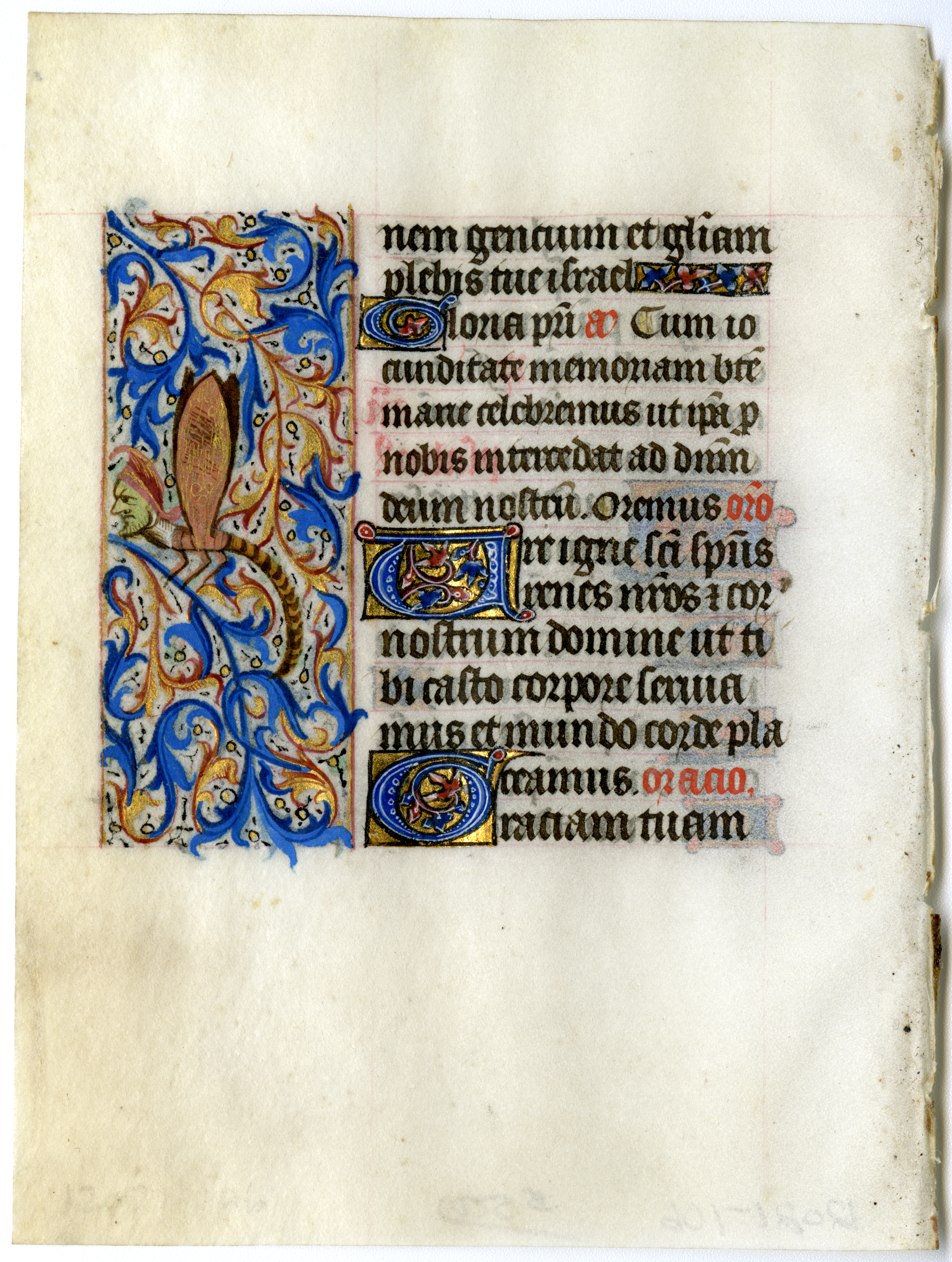
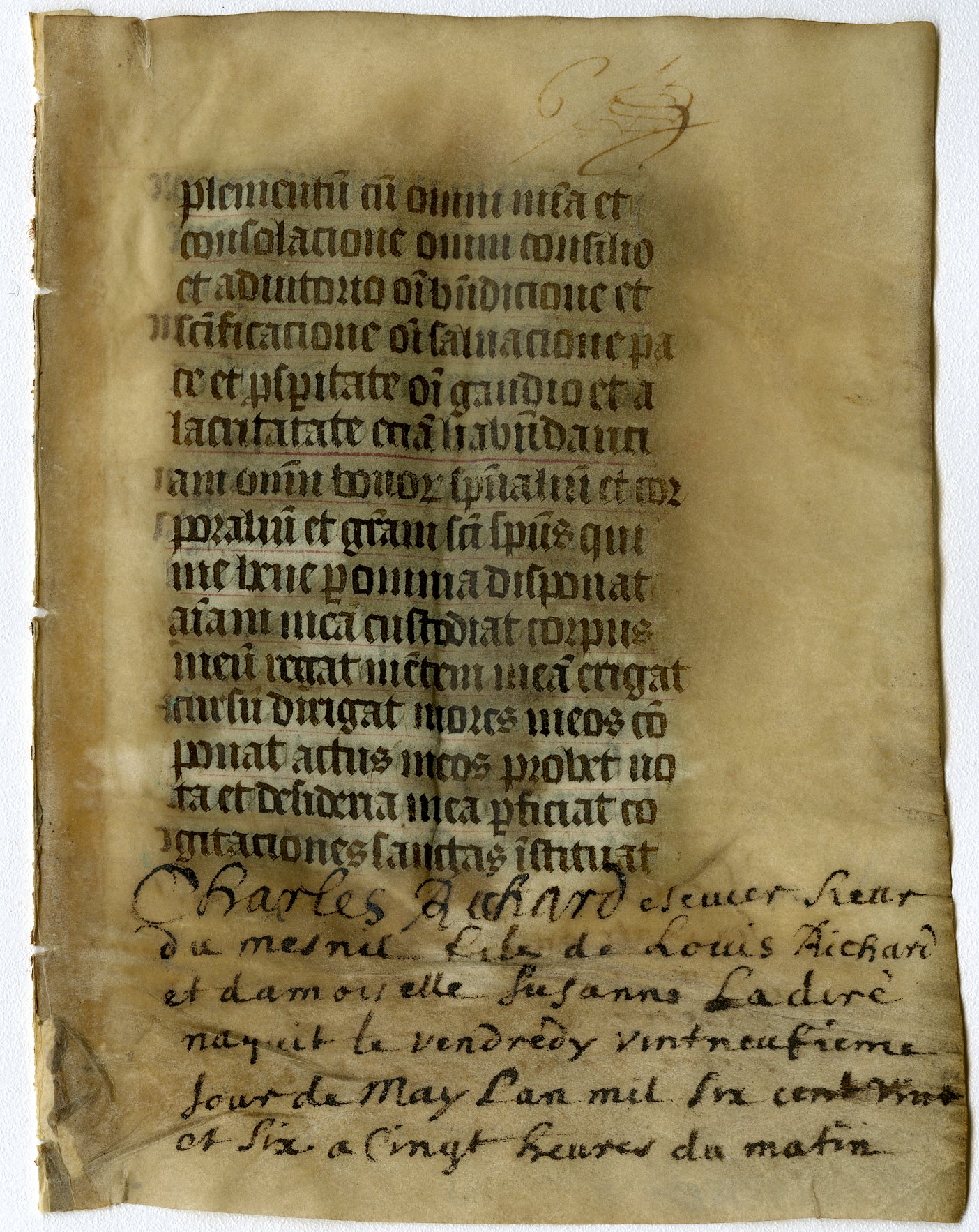
There is a Book of Hours (1685) bound in a simple blind ruled black Morocco. This binding has an unfortunately added shelfmark in addition to damaging adhesive tape. Finally, there is a fine art facsimile of a miniature, illuminated Book of Hours from the Vatican Library in brown leather with raised bands and gilt decoration.
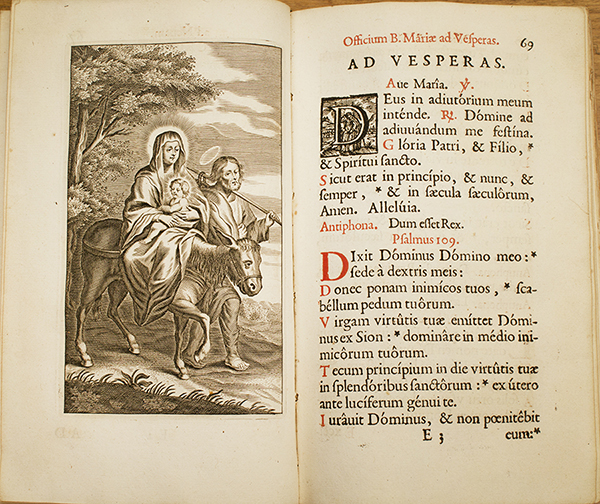
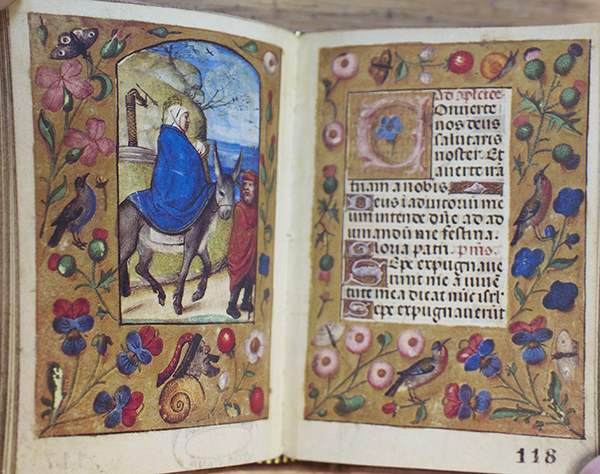
To read more about the Weinberg Library’s Rare Book Collection visit our collection page here. “From Medieval to Modern” will be on display during normal library hours through Tuesday, April 25. On Tuesday, April 11th, Special Collections Librarian Michael Knies will discuss the exhibit at 6 p.m. in the Heritage Room of the Library. A reception will immediately follow the talk. This event is free and open to the public. For more information, please email michael.knies@scranton.edu or call 570- 941-6341.
Fine Art Facsimiles: The Book of Kells and The Lindisfarne Gospels
A selection of rare materials from McHugh Special Collections is currently on view in the Library’s 5th floor Heritage Room. This week we are highlighting two fine art facsimiles from the exhibit “From Medieval to Modern”: The Book of Kells and The Lindisfarne Gospels.
In 1997, Special Collections acquired a fine art facsimile of the Book of Kells, donated by the estate of Charles J. Buckley, a dean emeritus who served the University in a variety of academic and administrative positions for 46 years.
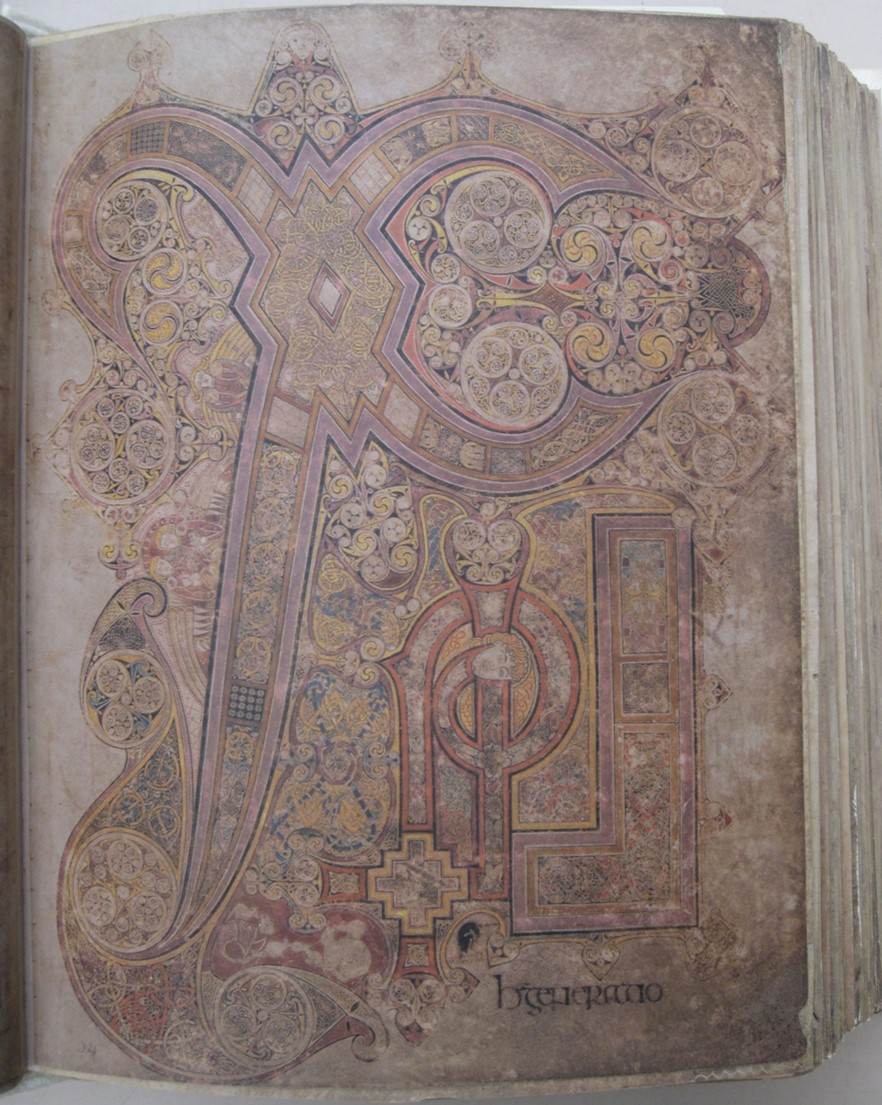
The original Book of Kells is believed to have been created around 800AD on the island of Iona off the coast of Scotland. Since the 17th century, it has been stored in the Library of Trinity College in Dublin. It is one of the world’s most famous illuminated manuscripts and is considered one of the greatest artistic productions of the Medieval period. The Book of Kells is a masterwork of Western calligraphy and represents the pinnacle of Insular illumination. It is also widely regarded as Ireland’s finest national treasure. The illustrations and ornamentation of the Book of Kells surpass that of other Insular Gospel books in extravagance and complexity. The decoration combines traditional Christian iconography with the ornate swirling motifs typical of Insular art. Figures of humans, animals and mythical beasts, together with Celtic knots and interlacing patterns in vibrant colors, enliven the manuscript’s pages. Many of these minor decorative elements are imbued with Christian symbolism and so further emphasize the themes of the major illustrations.
Only 1,480 copies of the facsimile of the Book of Kells were produced by the Fine Art Facsimile Publishers of Switzerland. The facsimile is owned by some of the most prestigious institutions in the United States, including New York’s Morgan Library and the Metropolitan Museum of Art. The facsimile edition took 10 years to produce and is considered to be indistinguishable from the original under museum viewing conditions. This accuracy extends to duplicating any damage and holes that appear in the original. The pages of the facsimile are identical in size and shape to the original manuscript pages. Of most importance to the viewer, however, is the impeccable color reproduction of the photographs. A special photographic book cradle was manufactured to hold the original safely. Kodak Ektachrome color transparencies were color corrected electronically, then passed to a lithographer who made additional color corrections by hand using as many as 10 printing inks per page. As the lithographer perfected the color balance, examples of the pages were compared with the original to fine-tune the color. After the pages were duplicated, they were sewn into gatherings hand-bound in a white skin, a book construction similar to the original.
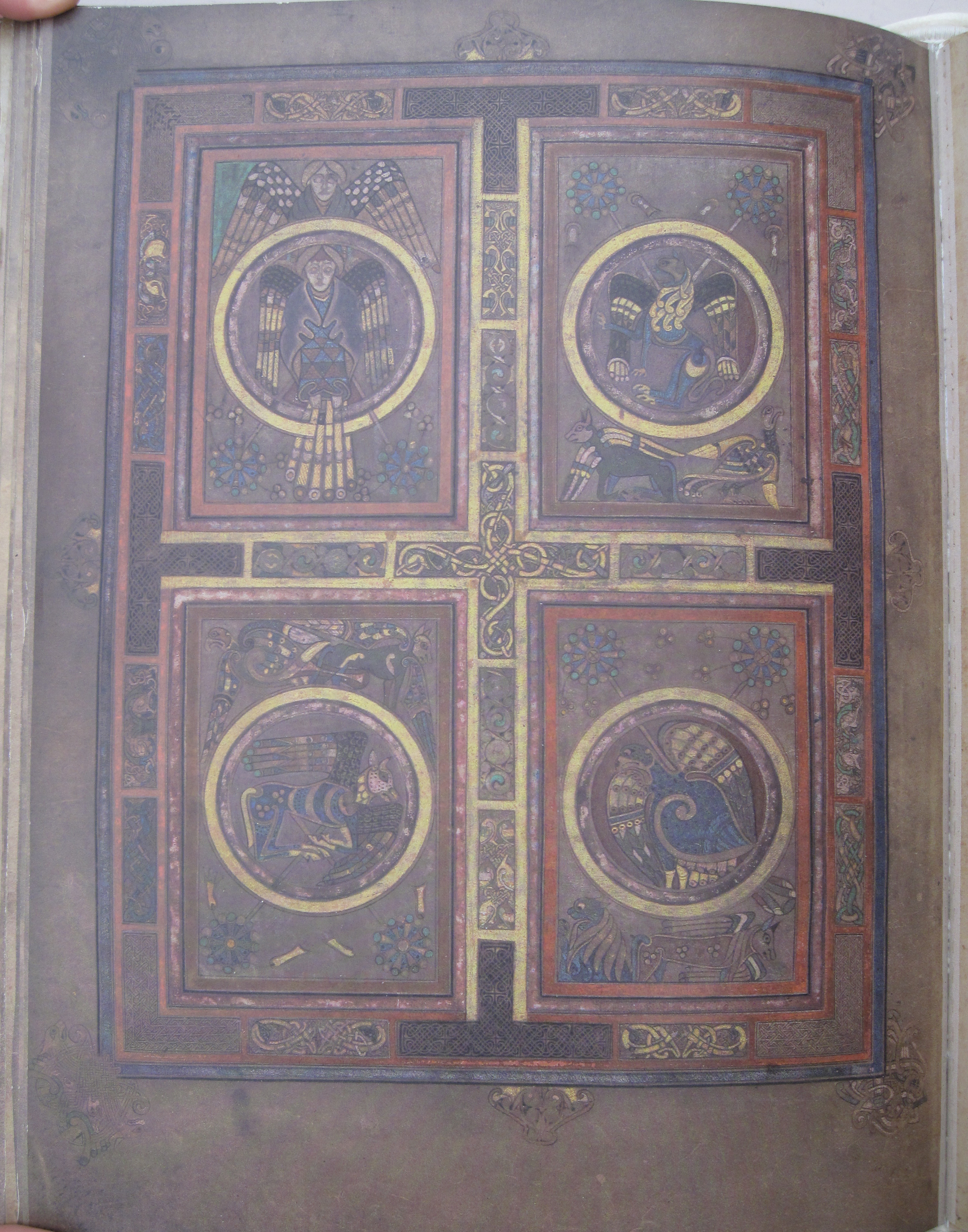
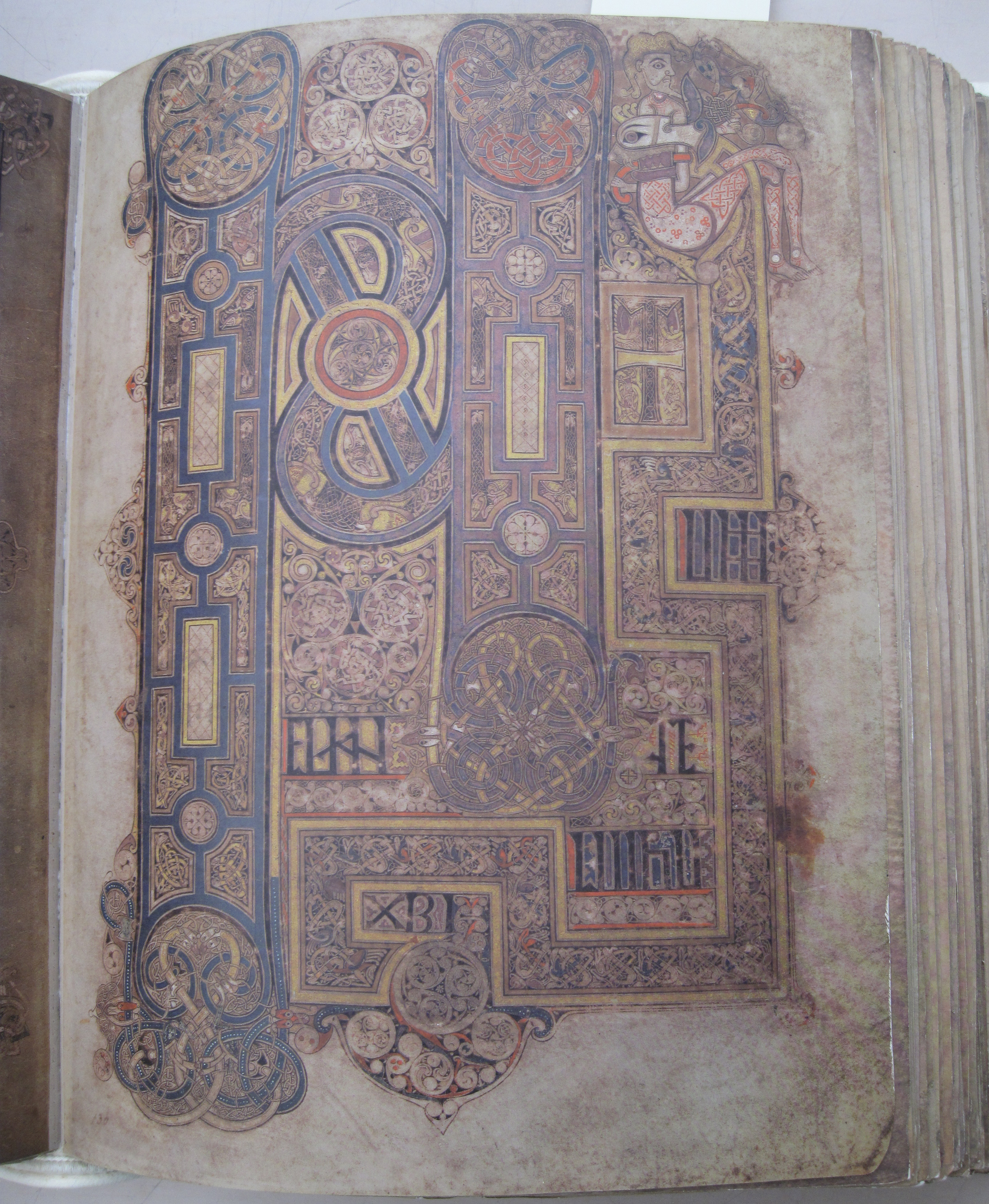
The Weinberg Memorial Library Special Collections recently received an extraordinary gift in honor of the 20th anniversary of the Library. Dr. Midori Yamanouchi, Friends of the Weinberg Memorial Library Board Member, provided funding for the acquisition of a fine art facsimile of the Lindisfarne Gospels. The original Lindisfarne Gospels is at the British Library in London and it is one of the most important and one of the best-preserved early medieval manuscripts.
 The Lindisfarne Gospels is an Illuminated manuscript gospel book created approximately 715-720 AD in a monastery at Lindisfarne off the coast of England. It is considered one of the best early versions of St. Jerome’s Latin Vulgate. The Lindisfarne Gospels also includes an interlinear Old English translation of the Gospels. This word-for-word English gloss was added to the Gospels around 950-970 AD. It is the oldest known translation of the Gospels into English.
The Lindisfarne Gospels is an Illuminated manuscript gospel book created approximately 715-720 AD in a monastery at Lindisfarne off the coast of England. It is considered one of the best early versions of St. Jerome’s Latin Vulgate. The Lindisfarne Gospels also includes an interlinear Old English translation of the Gospels. This word-for-word English gloss was added to the Gospels around 950-970 AD. It is the oldest known translation of the Gospels into English.
The fine art facsimile of the Lindisfarne Gospels was produced in 2002 by Faksimile Verlag of Luzern Switzerland, a company that specializes in the highest quality reproductions of liturgical medieval manuscripts. The facsimile was produced in cooperation with the British Library using state of the art digital photographic technology.


To read more about the Weinberg Library’s Rare Book Collection visit our collection page here. “From Medieval to Modern” will be on display during normal library hours through Tuesday, April 25. On Tuesday, April 11th, Special Collections Librarian Michael Knies will discuss the exhibit at 6 p.m. in the Heritage Room of the Library. A reception will immediately follow the talk. This event is free and open to the public. For more information, please email michael.knies@scranton.edu or call 570- 941-6341.
Dante’s Divine Comedy and the Complutensian Polyglot Bible (1514)
A selection of rare materials from McHugh Special Collections is currently on view in the Library’s 5th floor Heritage Room. This week we are highlighting two recent special acquisitions from the exhibit “From Medieval to Modern”: a facsimile of La Divina Commedia Di Dante Alighieri: Manoscritto Pal 313 and the fifth volume of the Complutensian Polyglot Bible.
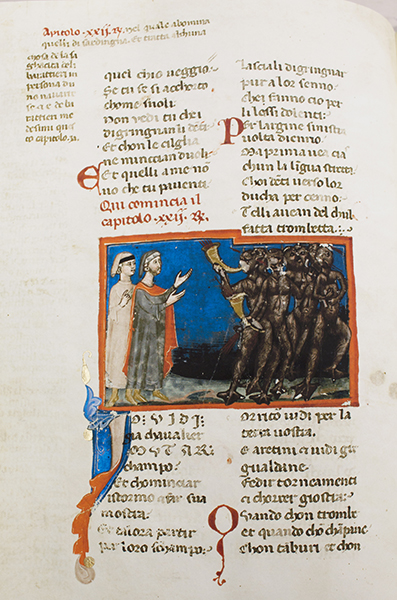
Thanks to the generosity of the Friends of Weinberg Library, McHugh Special Collections was able to purchase a fine art facsimile of the 14th-century manuscript of Dante’s Divine Comedy. The original manuscript is preserved at the Biblioteca Nazionale in Florence.
The Divine Comedy (written c. 1308-1320) is widely considered one of the greatest works of both Italian literature and world literature. The poem describes Dante’s (c. 1265 – 1321) travels through Hell, Purgatory, and Heaven in its three parts: Inferno, Purgatorio, and Paradiso, but on a deeper level is an allegorical representation of the soul’s journey towards God.
Written in littera textualis (also known as “book hand” or Gothic script), the original manuscript dates between 1333 and 1345 and is known as the Dante Poggiali, after Gaetano Poggiali, the scholar who discovered it in 1800. It is considered the first illustrated Divine Comedy ever produced and is the only surviving manuscript of its kind before 1350. This illuminated version contains 37 precious miniatures for the Inferno by the Florentine workshop of Pacino di Buonaguida. A lesser-known artist in the 14th century, Pacino took inspiration from fellow Florentine artist Giotto in his compositions for the Inferno scenes. In addition to altarpieces, Pacino painted miniatures and decorations for illuminated manuscripts. He is now considered the inventor of miniaturism, a style distinguished by a clear organization of the painting surface into multiple small-scale scenes. The Getty Museum has described Pacino’s work as having “a strong sense of expressiveness and drama.” The miniatures for the Inferno were created using tempera, gold leaf, and ink on parchment. The book also features textual glosses by Dante’s son Jacopo Alighieri whose Commento is a commentary of the text of the Inferno.
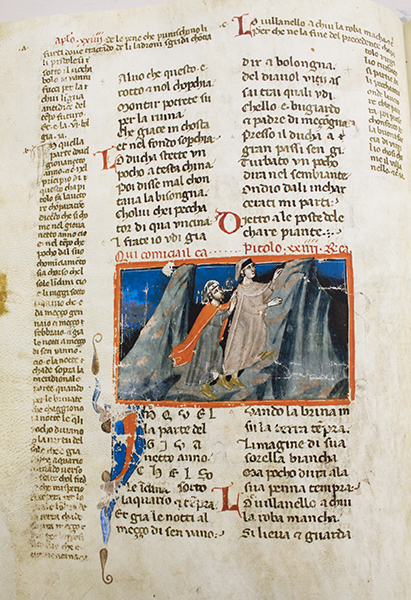
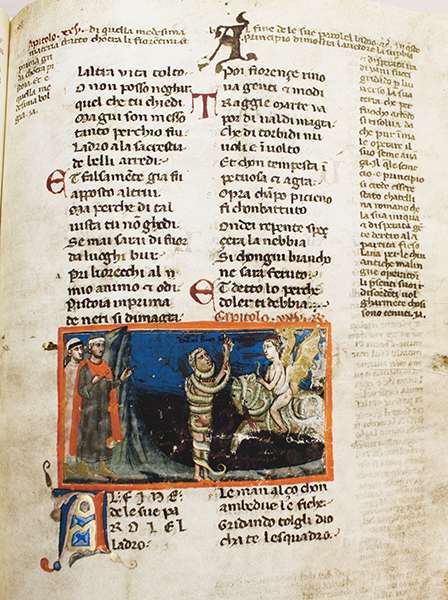
McHugh Special Collections received an important rare book donation from Paul Swift ’75 who donated the fifth volume (containing the New Testament) of the Complutensian Polyglot Bible printed in 1514 at Complutense University in Madrid for Cardinal Francisco Jiménez de Cisneros (also known as Ximenes de Cisneros).
This New Testament is from a landmark six volume Bible printed in multiple languages. The Complutensian Polyglot was the first multi-lingual Bible printed in Europe and portions contain Hebrew, Greek, Latin and Aramaic. Work on the polyglot commenced around 1502 but it took until 1517 for printing to be completed. It then took until 1520 to gain papal approval. The donated volume is the first Greek language New Testament printed in Western Europe (also printed in Latin). Mr. Swift donated it in memory of his great aunt Nellie Brown, who purchased the bible in 1931. She was the first woman to take an evening course at St. Thomas College in 1938 and went on to become a medical doctor. He also donated it in memory of his cousin Frank Brown who taught in the history department.
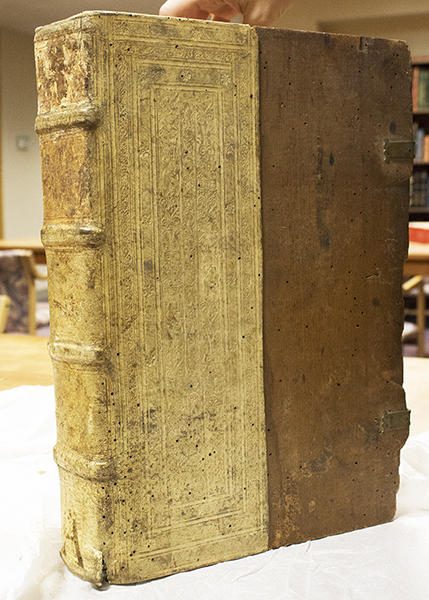

To read more about the Weinberg Library’s Rare Book Collection visit our collection page here. “From Medieval to Modern” will be on display during normal library hours through Tuesday, April 25. On Tuesday, April 11th, Special Collections Librarian Michael Knies will discuss the exhibit at 6 p.m. in the Heritage Room of the Library. A reception will immediately follow the talk. This event is free and open to the public. For more information, please email michael.knies@scranton.edu or call 570- 941-6341.
Cicero’s Rhetorica ad Herennium (1481)
A selection of rare materials from McHugh Special Collections is currently on view in the Library’s 5th floor Heritage Room. One of the books highlighted in the exhibit “From Medieval to Modern” is Marcus Tullius Cicero’s Rhetorica ad Herennium.
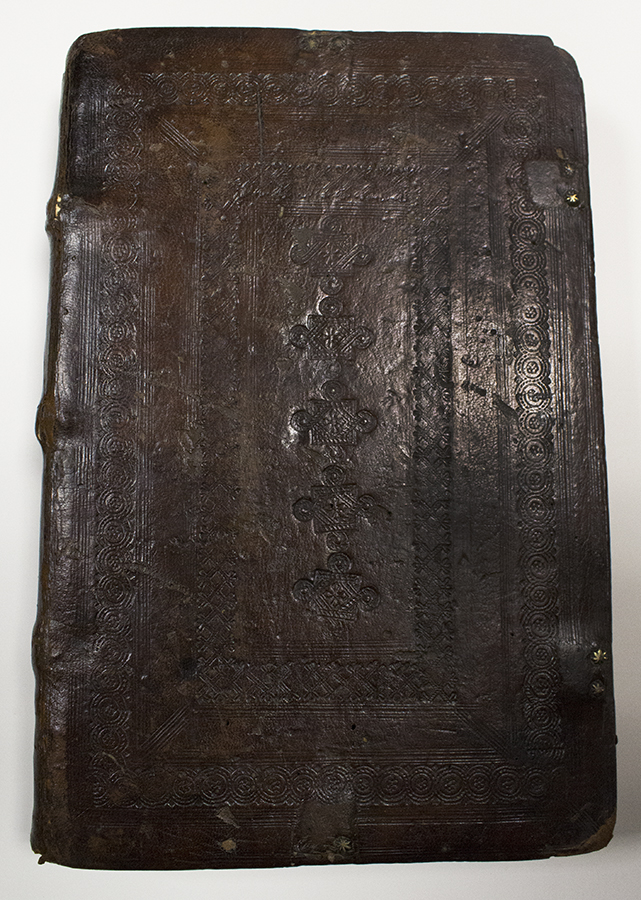
Marcus Tullius Cicero (106 BC – 43 BC) was a Roman philosopher, politician, lawyer, orator, consul, and constitutionalist credited with introducing Romans to Greek philosophy and being the innovator of what became known as Ciceronian rhetoric.
This book, printed in Venice in 1481 by Baptista de Tortis, and in its original blind-tooled (uncolored decoration) binding, has a wealth of information on its provenance (history of ownership). Nicholai Risi, about whom nothing is currently known, likely originally owned the book. He was responsible for the amateurish initial letters and the marginal annotations. Books printed during the first decades after Gutenberg’s printing press usually omitted the large opening paragraph initials expecting the owner to have them supplied by a scribe following the medieval manuscript tradition. Nicholas decided to write them himself (See image below). One might guess that he was a poor student and could not afford to pay for the work to be done but the book is in a fairly elaborate binding which would have been fairly expensive.
The book was later owned by the Honorable Frederick North. This Frederick North was the 5th Earl of Guilford (1766-1827), governor of Ceylon, and a significant book collector. (His father, Lord Frederick North was prime minister of Britain during the American Revolution.) Books bearing our Frederick’s book plate can be found in a number of libraries and his personal library was dispersed at eight London sales between 1828 and 1835. Finally, the book was owned by W. W. Scranton who purchased it in 1871 apparently for the price of $17.50 which would have been about three week’s wage for a laborer at the time. Where the book resided between the dispersion of North’s collection and William Walker Scranton’s acquisition is unknown.
To read more about the Weinberg Library’s Rare Book Collection visit our collection page here. “From Medieval to Modern” will be on display during normal library hours through Tuesday, April 25. On Tuesday, April 11th, Special Collections Librarian Michael Knies will discuss the exhibit at 6 p.m. in the Heritage Room of the Library. A reception will immediately follow the talk. This event is free and open to the public. For more information, please email michael.knies@scranton.edu or call 570- 941-6341.
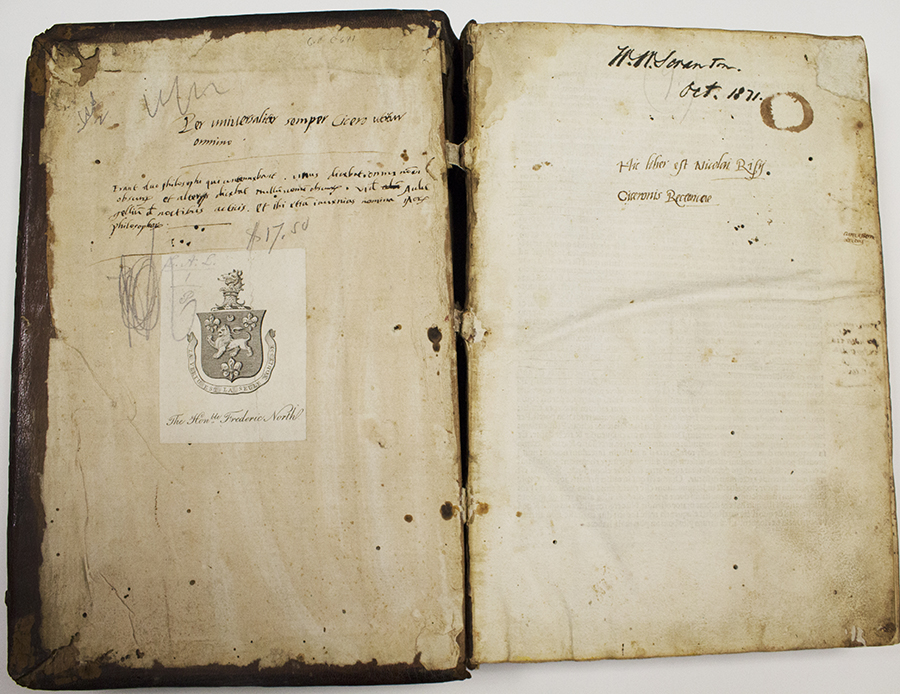

Athanasius Kircher’s Ars Magna Sciendi Sive Combinatoria (1669)
A selection of rare materials from McHugh Special Collections is currently on view in the Library’s 5th floor Heritage Room. One of the books highlighted in the exhibit “From Medieval to Modern” is Athanasius Kircher’s Ars Magna Sciendi Sive Combinatoria (1669).
Athanasius Kircher, S.J. (1602-1680) was a German Jesuit scholar and polymath who published approximately 40 major works in a wide range of fields, most notably in the fields of comparative religion, geology, medicine, technology, music, and Egyptology. Because of his enormous range of interests, Kircher has been called the “last Renaissance man” and “Master of a Hundred Arts.”
His Ars Magna Sciendi Sive Combinatoria (Amsterdam, 1669) was an attempt to use logic to categorize all knowledge under the nine attributes of God, an expansion of the “Combinatoric Art” of Ramon Lull, the thirteenth-century Majorcan philosopher. Kircher argues that these nine ideal attributes are the pattern for all creation and that to completely understand the universe, it must be organized in the mind according to this pattern. Consequently, Kircher designs a system for teaching all disciplines in the style of the encyclopedic movement. However, Kircher’s work is not pedagogical, but rather advocates a scientific method to finding truth, a logic applicable to all divisions of learning. In the book, Kircher applies this to numerous disciplines such as theology, medicine, and logic.
To read more about the Weinberg Library’s Rare Book Collection visit our collection page here. “From Medieval to Modern” will be on display during normal library hours through Tuesday, April 25. On Tuesday, April 11th, Special Collections Librarian Michael Knies will discuss the exhibit at 6 p.m. in the Heritage Room of the Library. A reception will immediately follow the talk. This event is free and open to the public. For more information, please email michael.knies@scranton.edu or call 570-941-6341.
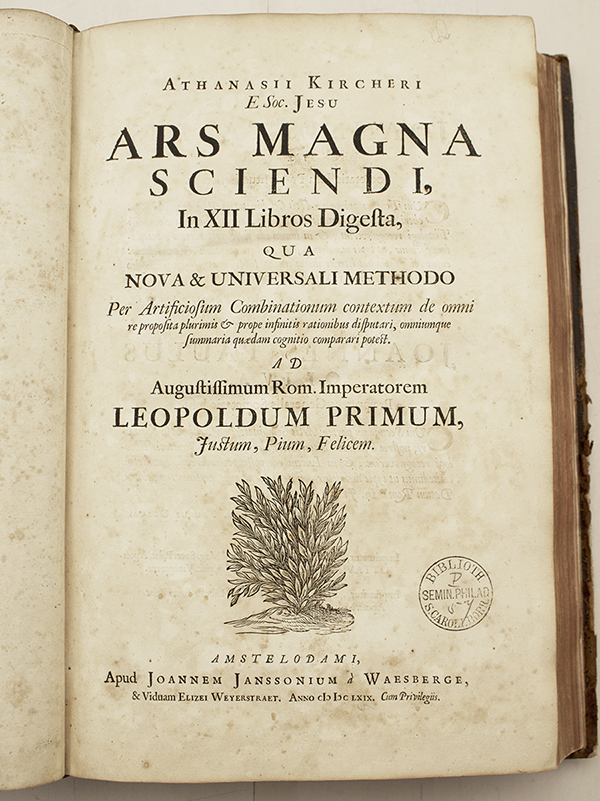
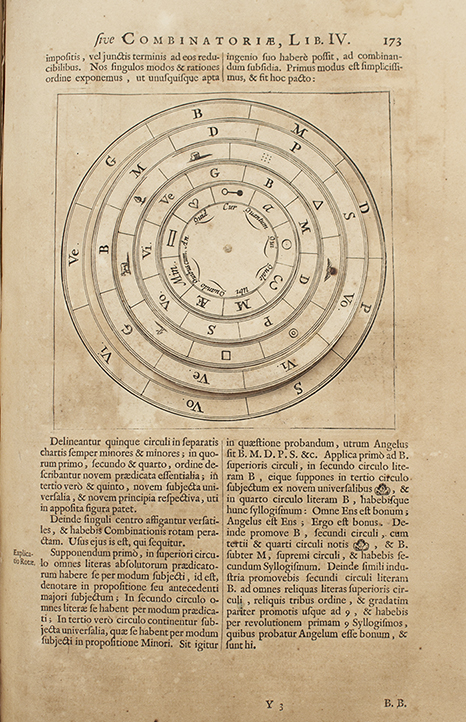
From Medieval to Modern: Rare Book Exhibit Now on Display
The exhibit will be on display during normal library hours through Tuesday, April 25. On Tuesday, April 11th, Special Collections Librarian Michael Knies will discuss the exhibit at 6 p.m. in the Heritage Room of the Library. A reception will immediately follow the talk. This event is free and open to the public. For more information, please email michael.knies@scranton.edu or call 570- 941-6341.
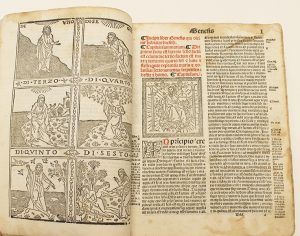
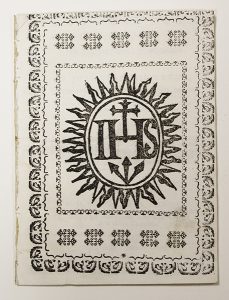
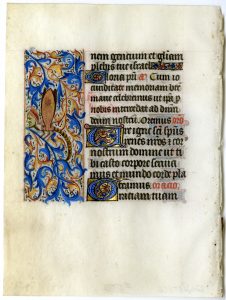

Library Exhibit: Highlights from the Helen Gallagher McHugh Special Collections
Brian E. McHugh ’59 recently announced a planned estate gift to the Weinberg Memorial Library in memory of his mother, Helen Gallagher McHugh. In memory of Mr. McHugh’s mother, the Weinberg Memorial Library’s Special Collections were named the Helen Gallagher McHugh Special Collections. Mrs. McHugh was born in Kingston and resided in Plymouth.
In honor of the naming and dedication, the Library is currently hosting an exhibit with a small and selective sample of the Helen Gallagher McHugh Special Collections. Most of this material has been assembled since 1996, starting with the acquisition of the Joseph Polakoff Papers followed by the Joseph McDade Congressional Papers Collection. Although the Library had a small rare book collection, including four mostly complete medieval manuscripts and a handful of books printed prior to 1500, the collection has been significantly expanded through the creation of the Hill-Davis Jesuit Collection with initial funding from the Rousseau Memorial Fund and subsequent funding from the Jesuit Community. Other items have been acquired through the generosity of the Friends of the Weinberg Memorial Library, as well as through donations and purchases.
This exhibit is concentrating on the Helen Gallagher McHugh Special Collections. The department also contains the University Archives, which are not featured in this exhibit. Material from the University Archives was featured last year in an exhibit celebrating the 125th anniversary of the University. Archival material is regularly featured in Heritage Room exhibits and a significant amount is available online in the Library’s Digital Collections.
The exhibit is on display in the Library’s fifth floor Heritage Room until September 25. For more information about the exhibit, please contact Special Collections Librarian Michael Knies. michael.knies@scranton.edu (570) 941-6341



